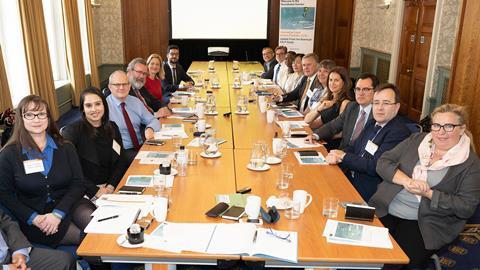With an annual market value of £8.3bn alternative legal service providers are now mainstream, but can they sustain their meteoric rise? Jonathan Rayner reports from a Law Society Thomson Reuters roundtable
There are major players in the legal services market that are notable for the absence of a person’s name on their letterhead. They are called Axiom, or Elevate, or QuisLex, or Pangea3 Legal Managed Services. Not the familiar founding partner-inspired formula of Allen & Overy, Moon Beever or Slaughter and May. There is no person’s name because these new entrants are limited companies that operate outside the traditional law firm partnership model. Among several advantages, this means they are not hampered by the influence of often conservative older partners and so are free to embrace new technologies and practices that can deliver legal services in more efficient and cost-effective ways.
These new players are the so-called alternative legal service providers (ALSPs) – or law companies, as they are also sometimes called – and are the subject of a Thomson Reuters report produced in conjunction with Georgetown Law, Oxford Saïd Business School and UK research company Acritas. The report examines the growing use of ALSPs by corporate in-house legal departments and law firms. It identifies the types of services in which ALSPs are gaining traction and looks at whether they are a growing threat to law practices. And it asks whether ALSPs can sustain their meteoric rise within the legal services sector.
This roundtable discussion, held at the Law Society on 30 April, debates the findings of the report. One of the report’s authors, Oxford Saïd Business School professor Mari Sako, begins by explaining the methodology: ‘We surveyed more than 500 respondents across the US, UK, Canada and Australia. Some of these were small, medium and large law firms and some were corporate in-house legal departments. Acritas, who collaborated with us, also interviewed 35 ALSPs. This is the first time we have had a perspective from the provider side as well as from the user side.’
Mainstream move
Sako goes on to question whether the ‘alternative’ in ALSP is still appropriate given that the newcomers are now ‘mainstream’ with a market share valued at £8.3bn annually. The signs are, moreover, that this market will only get bigger. The growth in the use of ALSPs by US corporations, for example, has been much higher than was projected two years ago when the last report on this topic was published. Further boosting growth in the ALSP sector, one-third of the law firms that responded to the survey, says Sako, ‘plan to establish their own ALSP affiliates over the next five years’.
She next draws attention to a table comparing corporations’ use of ALSPs by country. ‘Usage in the US is very much focused on electronic discovery services. That’s 28% of surveyed corporations in the US as opposed to just 17% in the UK.’ Litigation and investigation support shows a similar disparity, with the US on 38% in contrast to the UK’s 16%. Commenting on this second finding, Sako says: ‘In the US, they have more open e-discovery rules than the UK, particularly in the wake of recent UK reforms intended to lower litigation costs by restricting discovery. And then there is the culture of US corporations being more litigious as well.’
She moves on to comparing law firm usage of ALSPs by country. Again, medium and large US law firms, Sako notes, are ‘very much focused on the discovery and litigation area, whereas UK firms are using ALSPs across many more different practice areas,’ such as legal drafting, mergers and acquisitions due diligence, project management and corporate transaction management.
Sako concludes: ‘In what ways do these differences matter? In my view, it’s primarily thinking about where innovative practices and technological innovations can be most usefully applied. It is also something that might affect the ways in which corporates actually use law firms versus ALSPs.’
Moderating the event, the Law Society’s director of strategic relationships Stephen Denyer invites comment from the roundtable delegates. ‘What do people think about the ALSP name?’ he asks. ‘Somebody very sternly told me that I should be calling them law companies, for example. And what about the analysis, what do people think about that?’
Acritas CEO and founder Lisa Hart Shepherd says: ‘It’s very interesting the way that UK corporates, compared with US corporates, seem to be much less sophisticated. They’re using legal tech and ALSPs less. And yet the opposite is the case with law firms, who are using more of both. Maybe UK corporates are lazier. Or is it because the firms are doing it for them so they don’t need to be actively searching for innovation?’

Trade Finance Bank general counsel (GC) Joseph Crowley suggests that budgetary pressures explain corporates’ unwillingness to invest in new ways of doing things: ‘If you are in-house legal in a corporate, you are a minute part of an organisation and you are a cost centre. You’ve got to show that you are critical to the overall business strategy and fight very hard to be allowed to spend anything. With law firms, on the other hand, it’s their business. They have to invest in innovation because it’s fundamental to their strategy.’
SQE opportunities
James Catchpole, City Law School’s director of legal practice, wonders what opportunities ALSPs might open up for those seeking an alternative route to qualification: ‘What will be interesting is how these organisations respond to the regulatory change coming in with the Solicitors Qualifying Examination (SQE).’ For example, ALSPs will be required to cater for people studying for the SQE who want to demonstrate qualifying work experience, which might be second nature for law firms, but new to other legal services providers.

Herbert Smith Freehills partner Libby Jackson agrees: ‘Yes, we’re very interested in how that will evolve. We’ve had a training contract at our Belfast [alternative legal services practice group] office for a long time and we also do a similar programme in Australia and other parts of the world. We’re keen to give people career progression within these models, which is absolutely key to our success in growing talent for the future and evolving specific types of niche expertise that we will need.’

Catchpole sounds a note of caution. ‘The risk is that you could end up with a bottleneck of people sitting in these organisations who want to qualify, but are unable to move on because they don’t have the experience firms want. As Libby says, they’re going to be very niche in what they’re able to do and very good at doing it, but maybe their aspirations will be hindered. It will be interesting to see how employers respond to that, because it will impact on their ability to recruit and also on who wants to join them.’
Jackson says: ‘You mentioned aspirations. Are these partnership aspirations within the traditional law firm model? Or are they more interested in a career path that looks different?’
Catchpole replies: ‘It changes. When you get them at newly graduated level, they want to be a lawyer in a law firm environment. But once you’ve worked with them and once they’re out in the real world, they then realise that actually there are alternative routes and career progressions that also give them opportunities.
‘Corporate governance frequently comes up at this stage. I’ve got lots of students who have opted for the corporate governance path, including within alternative providers. They’re sitting there waiting, knowing that there is a route, that it’s highly regarded, that it’s a growth area and that it’s a potential qualification area. I think this is where their change of aspiration comes in. They don’t see themselves necessarily wanting to be the traditional lawyer, but a lawyer who is qualified within an area and has a specialisation and expertise. This will offer adaptable and realistic students a way into qualification, but with a very different outcome in terms of career path.’
Law Society Gazette features editor Eduardo Reyes says: ‘I think the challenge for traditional law firms that have opened reduced overheads centres in such places as Belfast, Manila, Warsaw and Manchester is to show that you can still get the glittering prizes if you start your career there.’
Anil Kurukulasooriya, an in-house solicitor at the Bank of New York Mellon, says: ‘If you start in one of those centres, there might be a perception that you’ve got further to go and more to do to prove yourself. I know a lawyer who started in a Belfast support team and worked her way up to partner in a London law firm. If you’re good quality, you’ll always rise to the level that you aspire to.’
Cavan Fabris, formerly GC at Apple and HP, and now at EY, asserts that graduates are not presently being trained to meet the multi-disciplinary requirements that legal services purchasers demand. ‘It’s a given that lawyers are going to be technically competent, but they also need to be project managers and business developers. Decisions for legal services are no longer being made by GCs. They’re being made by chief finance officers who see legal services as a cost that needs to be measured against performance driving the business forward.

‘Many businesses buying legal services are saying they are going to use a legal managed service provider. They’re going to automate as much as they can that is repeatable and standardised. And they’re going to move it nearshore or offshore for cost purposes. The idea of having traditional, transactional support that is not specialised done in expensive cost centres like London, Los Angeles and New York is fast becoming antiquated.’
Kurukulasooriya agrees that corporations are looking for more than simply legal skills: ‘Firms I’ve worked for used ALSPs for outsourcing the project management function, or contract management, or legal drafting. The latter might be in relation to regulatory implementation and so you would create the playbook of how to review and amend contracts, interact with clients and have fall-backs. You pass the playbook on and let people work their way through it. That’s just one example. Obviously the scope of services has broadened hugely to encompass all sorts of other disciplines.’

Thomson Reuters business development director Shahin Baghaei says that the initial driver for using an ALSP is often project work when GCs do not have the resources to increase the size of their teams. But it is more than just a matter of man power: ‘The ALSP provides a managed service that uses technology and gives back the metrics that allow the GC to have a leaner team giving legal advice around the project. But that’s just the beginning. We’re developing to really understand how ALSPs can help us identify the new breed of legal professionals who are client-facing negotiators, ones that understand our internal processes and understand how to interact with a client – and can do it all effectively and efficiently.’
Jill Whitehouse, chief operating officer and GC of global search business SSQ Group, is asked whether ALSPs, by providing specialists to meet client needs, are proving a ‘disruptor’ to her company’s operations. ‘No, not at all,’ she replies. ‘For us there are incredible opportunities here because we have the one thing that they all want – we have the people.’
Open to innovation
Denyer now invites Hart Shepherd to speak on the second half of the report. She begins by saying that in-depth interviews were undertaken not only with ALSPs, but also with law firms that are experimenting with ALSP strategies. ‘Who you hang out with dictates how you act,’ she states, ‘so it’s good for law firms to encourage their partners to collaborate with ALSPs – it shows they are open to innovation. As for the ASLPs themselves, they’re moving up the value chain in terms of the type of work they want to do.’ Project management services head the list of the types of work they want to do, descending through contract lawyers and staffing down to intellectual property management.
Hart Shepherd moves on to document ALSPs’ high rates of growth. ‘Law firms would die for the level of growth that ALSPs are experiencing,’ she says. ‘The average was 25% for everybody we spoke to year-on-year, but some grew 200% or 300% when they were starting from a low base. Size was also very variable, from zero employees – they worked only with contractors – to 30,000 people on their database.’

There are some barriers to growth, notably the scarcity of talent and resource available to feed the rapid growth of ALSPs. Also, many law firm partnerships voice the fear: ‘Is this going to eat away at my practice if I start to collaborate with these folks internally?’ Hart Shepherd observes. ‘Compensation models haven’t evolved to reward partners for bringing in these new types of services, so it’s going to hit them financially as well as reduce the size of their practice. The current compensation model is very short-term - usually for partners it’s what happened last year – so there’s little incentive to commit to a long-term arrangement with an ALSP.’
Management consultancy Cambridge Strategy Group director Robert Millard recalls a conversation he had recently with the GC of one of Britain’s biggest corporations. The GC complained that ALSPs were becoming increasingly like law firms with business models still tied to the billable hour. And yet technology is constantly being held up as the next big thing. ‘We all talk about what the future might hold,’ says Millard, ‘but most of these machine-learning and document-assembly tools are still quite rudimentary. Even the biggest law firms don’t really have enough data to make machine-learning work for them.
‘I’ve spoken to two law firms recently who’ve talked about taking work back in-house that they’ve previously outsourced to cheaper suppliers, but which they can now do profitably themselves. As this convergence goes on, what is going to be the unique selling point for an ALSP as opposed to what law firms are evolving to become?’
Hart Shepherd says: ‘Law firms mostly regard other law firms as their main competitors, not ALSPs or the Big Four. Law firms are still quite arrogant and may have some shocks ahead.’

She turns her attention to the Big Four: ‘We detected interesting themes around their perceived advantages and disadvantages. There’s a big fear around the embedded relationships they have across every corporation in the world. They can leverage these relationships. They also have excellent reputations and have quietly been growing their legal offering for a decade or more. No law firm can match their depth of resource; they have deep, deep pockets.’
Drawing her presentation to a close, Hart Shepherd briefly touches upon pricing. ‘Our research suggests that ALSPs have gone in too hard on pricing, with the effect that they are not always making enough profit to attract future talent. Perhaps they should build more room for profit to allow themselves to invest in better talent and other types of expansion.’
She ends with some questions: ‘There are new ALSPs emerging every day so it’s becoming a crowded market. Will the current rate of growth be sustainable? How will they attract quality talent? Market consolidation is already happening. How do ALSPs collaborate with law firms as the latter increasingly develop similar offerings?’
A number of observations follow. Baghaei cautions: ‘We need to differentiate between the business of law and the practice of law.’
Jackson warns: ‘Many of us in this room love the legal tech stuff, but when it actually comes down to building products that clients can understand and want to buy, we’ve left them far behind.’
But perhaps the most telling exchange of views is that between Jackson and Fabris. She says: ‘It would be naive to think that the Big Four are not absolutely geared up to have all the right legal advisory complementary skills that clients could require. They can truthfully tell them we’re here to solve your problem by bringing together the suite of expertise that you need. Be that advisory, be that technology, be that process. That’s why I’m scared of that man [Fabris] over there. I think we all need to be.’
Fabris responds: ‘We are equally envious of the long-term relationships that law firms have established. EY Law has been around for just four years in this country. That’s a short time to get established as a legal services provider. We still have a long way to go to entrench ourselves as deeply as law firms have in their relationships with clients.’

Photographs by Noah Da Costa
On April 3, 2019, Thomson Reuters and EY announced an agreement for the acquisition of the Thomson Reuters Pangea3 Legal Managed Services business by various firms in the EY network. Pangea3 is an award-winning leader in legal managed services, with eight service delivery locations on three continents. The acquisition will bolster the ability for EY Law practices to help clients around the world transform their practices and deliver meaningful value to their businesses.

















![David Lester (senior partner at Blythe Liggins), Darryl Barnes, Jagdeep Sandher (head of dispute resolution at Blythe Liggins)[4]](https://d1d8vslyhr7rdg.cloudfront.net/Pictures/274x183/4/2/8/116428_davidlesterseniorpartneratblytheligginsdarrylbarnesjagdeepsandherheadofdisputeresolutionatblytheliggins4_981603_crop.jpg)










No comments yet